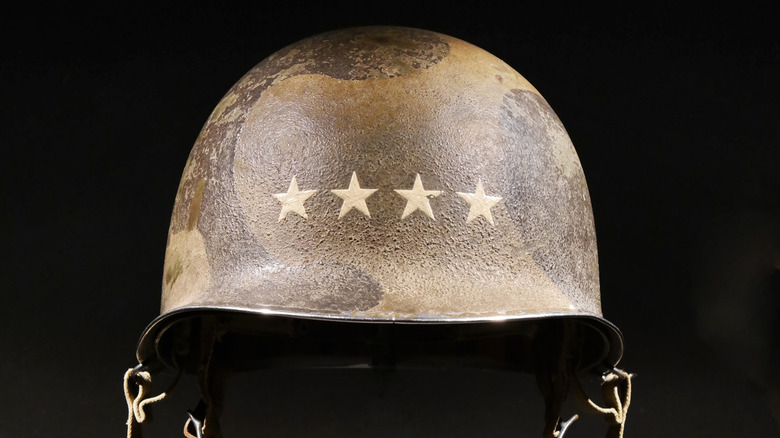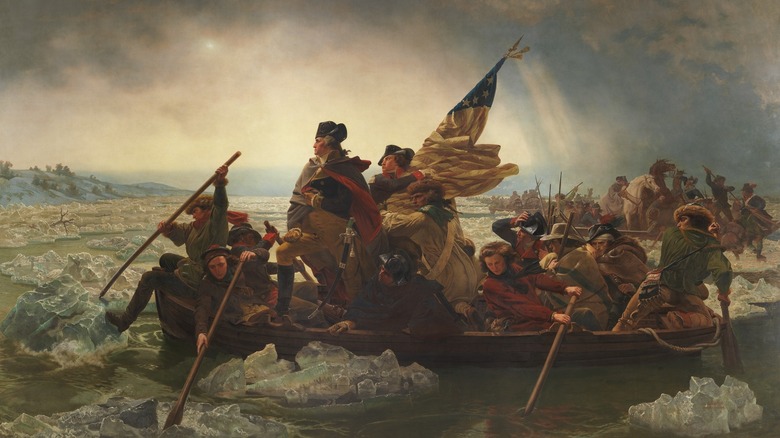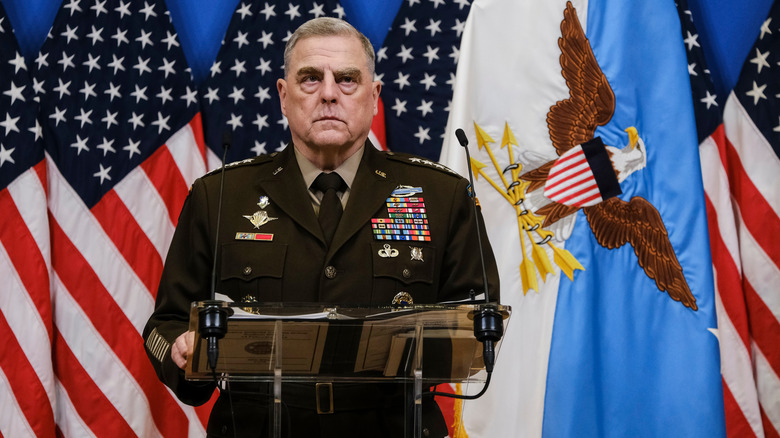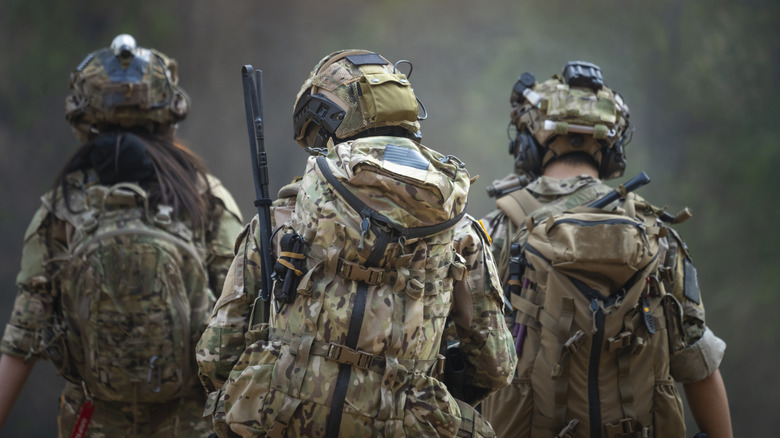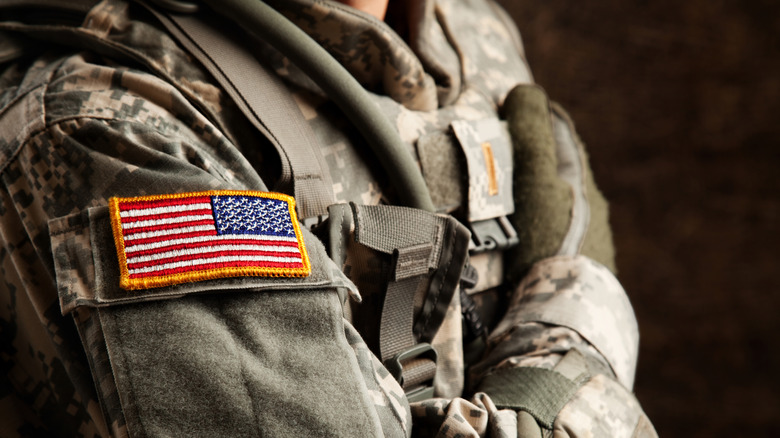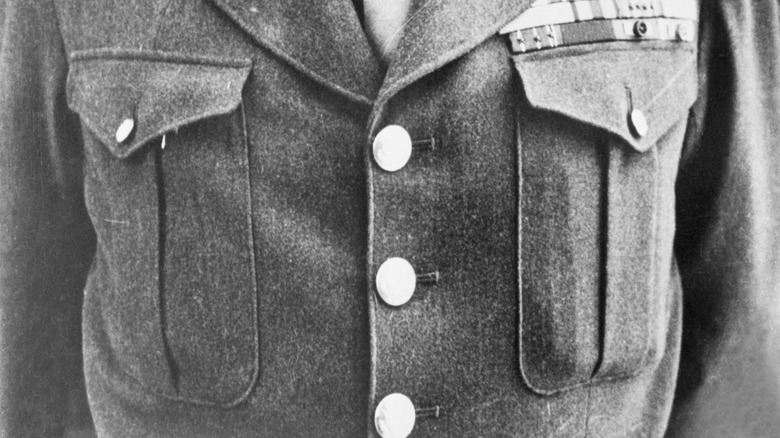What Do Four Stars On An Army Uniform Mean?
Most of you likely recognize the term "four-star general." It means "important Army person" or something, and maybe there are some actual stars somewhere on their uniform. You might have also heard terms like "brigadier general" or "major general" — terms doubtlessly garbled by movies and TV. Some of you might even remember that a late, prominent public figure like Colin Powell was a four-star general. And if there are four-star generals, what about the three-star ones? Does it really work like Yelp, Google, or Amazon reviews? Two-star generals, one-star generals, and so forth? What's the truth behind this mayhem?
No worries, we're here to clear things up. Yes, stars in general mean a general. If you spot one, two, three, or four stars on a military uniform, it means that person belongs to the highest echelon of Army rank. That is, the person is a "general" in the United States Army, Marines, Air Force, and Space Force (which we're obligated to remind you exists). Meanwhile, the highest rank in the military's water-based branches, the Navy and the Coast Guard, is the familiar "admiral."
Beyond this generality, more stars mean a higher rank. In order, this is one, two, three, and four stars. So yes, kind of like Yelp. Then there's the five-star general, which is an unoccupied rank that doesn't exist until wartime and has only been filled nine times in history, four of which happened during World War II and two of whom were George Washington and Ulysses S. Grant — just to show you the pedigree. From there, the specifics of generals get complicated.
The evolution of the modern general
Modern military rankings didn't crop up overnight. It took centuries of complex, messy development for our current, regimented military hierarchy to take form. As the McClellan Aviation Museum explains, the term "general" was one of the last ranks to crystallize. Pre-16th century, kings might appoint a "captain general" to oversee the army in his stead, or a "colonel general" who himself appointed a "lieutenant general" to be his attaché. Given the overlap in terms and roles, it was perfectly possible for someone to be a colonel, captain, and general all at once. And even then, "general" wasn't a permanent position — it was exclusively a wartime position, like a modern-day five-star general.
It wasn't until the 17th century that the role of "general" became permanent. Come the American Revolutionary War, the nascent nation adopted the military ranking conventions of the time. After that, the ranking system evolved until the modern day, which has equivalent ranks across all military branches.
The Army's ranking system operates in tiers and is separated into three groups: enlisted ranks, warrant officer ranks, and officer ranks. In the Army, enlisted (non-commissioned) ranks include E-1 through E-9 (private through sergeant major), warrant officer ranks include W-1 through W-5 (warrant officer 1 through chief warrant officer 5), and officer ranks include O-1 through O-10 (second lieutenant through general). The highest of that last group is the four-star general.
The duties of a four-star general
So what exactly does a general do? Fundamentally, a higher Army rank means more people under your command. It also means more responsibility for high-level, strategic decision-making rather than direct troop command. As the Army itself outlines, a sergeant (E-5) has four people under their direct command. This is the smallest organizational element of the Army, called a "team." A staff sergeant (E-6) — the next level up — manages two to three teams, called a "squad." A second or first lieutenant (O-1 or O-2) manages two to four squads, aka a "platoon," and so forth.
On and on it goes, until we reach the general levels, O-7 through O-10. From low to high, these ranks include brigadier general (one star), major general (two stars), lieutenant general (three stars) and plain and simple general (four stars). Brigadier generals (O-7) overlap a bit with colonels (O-6) and are in charge of a "brigade" numbering 1,500 to 3,200 people. This number includes non-commissioned officers, combat and support units, armored units, and special forces units like rangers. By the time we reach a lieutenant general (O-9), heading up a "corps," the rank is responsible for 20,000 to 40,000 lives.
Four-star generals get spread across a wide variety of joint commands and duties, governmental or otherwise, and oversee all of the U.S. Army's currently 450,000 people. As of 2020, there were 14 four-star generals in the Army, although General Mark Milley (pictured above) retired in 2023, making the total 13. This is still the highest number of four-star generals since World War II.
How do you become a four-star general?
Setting out to be a four-star general from the beginning of one's military career is quite the ambitious goal. Wearing four stars requires committing one's entire life to a single purpose, as it takes 30 years of service to even be eligible for the status. And since generals must be commissioned officers and officers can be commissioned from ages 17 through 35, that means someone can become a four-star general from the ages of 47 through 65. That entire time block of time must be spent rising through the ranks to the highest level possible while proving you're right for the job.
The details of the path to general are daunting, to say the least, and outlined on the Army's recruitment website. The first step is becoming an officer, a goal attainable through five different paths. University students can join the Reserve Officers' Training Corps (ROTC), for instance, or those who've completed four-year degrees can enroll in Officer Candidate School (OCS). You can even begin as a non-commissioned officer, go through the ranks, and take the officers' test.
After that, an officer has to pass through every single rank from second lieutenant (O-1) all the way through four-star general (O-10), with each having its own requirements before passing to the next level. Each level entails greater and greater responsibility, including commanding greater numbers of people. So if you see a four-star general? That person has gone through all of the above and more.
The meaning of stars, stripes, chevrons, and animals
Now that we've covered many of the ins and outs of what four stars on an Army uniform means, some folks might be wondering: Why stars, exactly? Each rank comes with its own insignia. Non-commissioned ranks often contain chevrons (or V-shaped stripes). Warrant officer ranks contain horizontal stripes with little blocks in them, or the stripe-in-stripe of a chief warrant officer 5. Lieutenants get horizontal bars, and captains get an insignia that looks like a capital "H." Majors get oak leaves and colonels get little eagles. Then we've got the single, double, triple, and quadruple stars of the general ranks. Was there any rationale behind any of these choices?
The truth is: We don't know the reasons for each rank's insignia. The Department of Defense, however, points out the connection between military insignias and medieval European heraldry. Notably, the emblems contain symbols meant to represent particularly families, lands, etc. Dating back to the 12th century, such heralds — the physical emblems — were attached to jobs of the same name. As a job, a herald was charged with delivering messages to opposing sides on a battlefield, so it was important to recognize who was approaching from a distance and to let the person pass. Hence the kind of emblem that evolved into modern military insignias. Perhaps stars are just the most impressive looking symbol folks could think of.
How to wear the four stars on a uniform
So where exactly on a uniform do a general's four stars go? For non-military personnel, it'd probably take some effort to think through pop cultural and sci-fi military imagery to arrive at a clear vision of real, contemporary U.S. Army uniforms. But as always, things are more complex than you might think, especially because there's no one, single outfit. There are combat uniforms, physical fitness uniforms, service uniforms (now dress uniforms), and the new 2018-inaugurated "Army Greens," which replaced the service uniforms ("Army Blues") as the everyday out-of-combat clothing for soldiers (but which will take until 2028 to fully implement). Each comes with its own layout and placement of artifacts like insignias of rank.
Judging by the Army Uniforms website, the physical fitness uniform is the simplest uniform by far and doesn't seem to denote rank anywhere. Combat uniforms are obviously more rough-and-ready than service uniforms and Army Greens, but still contain all the same elements: branch type, combat badge, special skill badge (like aviator or combat medic), flag patch, identification badge, unit patch, service stripes, duty tabs, name tape, and of course, rank patch. On the combat uniform, rank patches go smack dab in the center of the chest and on the hat. Meanwhile, on the service uniform (and presumably the new Army Greens), the rank patch goes on the beret and the epaulettes on the shoulders, not on the torso. No matter the rank, four-star generals included, this is the rule.
